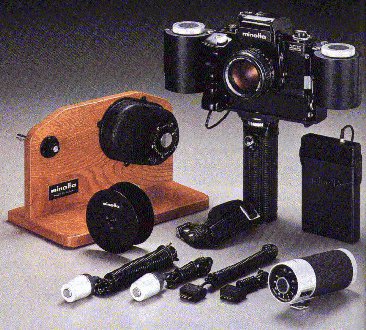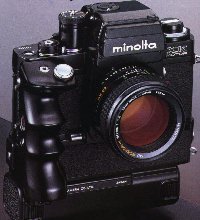 Click here for a high resolution image of the XK Motor
Click here for a high resolution image of the XK Motor
 Click here for a high resolution image of the XK Motor
Click here for a high resolution image of the XK Motor
Something many peole don't realise is that Minolta released a full pro specification camera to compete against the likes of the Nikon F3, Canon F1 and Pentax LX. This camera was available, unlike it's competitors, in two distinct variants with or with out motor drive.
History has forgotten the Minolta XK and XK Motor to some extent, but if you're after a solidly built and built to last camera they are there to use.
Personal opinion, and to some extent shown by history, is that most owners would have liked to be able to use the camera with or without motor drive depending on the task. Or more importantly added when finances permitted. Unofrtunately this was not the case and if you owned an XK Motor, that is exactly what it was.
As the specifications will show this is the only Minolta built to date that has had provision for both interchangeable focussing screens and interchangable finders. The standard prism was the AE-S finder that allowed full aperture priority operation from 1/2000th sec to 16 seconds.
The XK / XK Motor was known as the X-1 in Australia.
Type: 35mm single lens reflex with electronic focal plane shutter. Interchangeable finder/screen type. Integral motor-drive on XK Motor.
Lens Mount:Stainless steel Minolta SLR bayonet (MD)
Shutter:Electronically controlled focal plane type with titanium curtains and 2 mechanically controlled settings. Electronic speeds: 1/2000th sec to 16 seconds in steps, 8 to 1/2000th sec continuously variable. Mechanical settings X (1/100th sec.) and B.
Film Advance:Manual: lever type Motor Driven (XK Motor only): By single micromotor for S (single frame) or 1,2,3 and H (3.5 continuous frames per second). Automatic advance stop. Film advance locks when voltage insufficient.
Rewind: Manual, by crank; Motor-driven, by same motor as for film advance. Automatic rewind stop (tongue out).
Mirror: Oversize mirror, quick return type.
Flash Sync: X contact, 1/100th sec. and longer speeds; FP Contact, All speeds through 1/2000th sec.; single terminal with X/FP switch, direct contact on optional accessory for cordless flash unit.
Power Source: Exposure control, 2 alkaline-manganese or silver-oxide batteries (Eveready EPX-76/S-76 or equivalent); Motor Driven, 10 AA size batteries.
AE-S Finder: Eyelevel pentaprism wih built-in meter; automatic electronic and metered/manual exposure control. Full aperture TTL centre-weighted type by silicon photocell. Visible in findr: f number, LED/digital shutter speed indicator. Measuring range -2 EV to 17 EV (e.g. 8 sec. at f1.4 to 1/2000 sec at f8) for single frame operation, EV 3 to EV 17 (e.g. 1/4 sec. at f1.4 to 1/2000 sec at f8) for continuous operation with f1.4 lens at ASA 100.
Other Features: Multiple exposures; auto-exposure override control (+/- 2 EV), built-in auto senswitch; battery checkers for exposure and motor batteries; memo hlder and ASA-DIN conversion scale; remote control input jack.
Dimensions and Weight: Motor: 83x147.5x171mm; 1450g with AE-S finder and standard battery pack.
The AE-S Finder: Centre-weighted finder with silicon photocell. SPC has a response time of 1/100,000 of a sec. Allows for automatic selection of correct shutter speed in conjunction with rapid film advance. Camera will automatically override the frame rate when light levels are insufficient for correct exposure. Finder is interchangeable with plain finder, high magnification finder and a waistlevel finder.
Full Information Viewfinder:
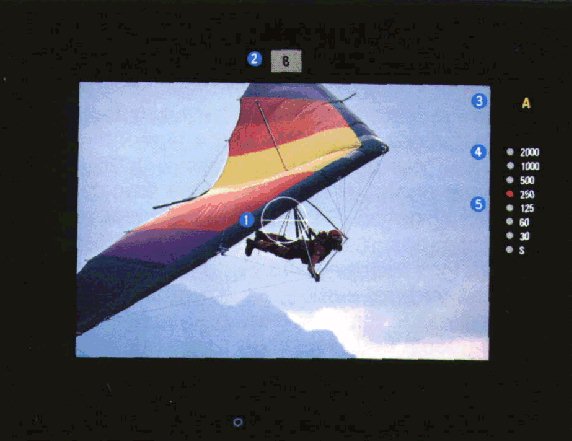
1. Split-image spot
2. F - number
3. Shutter-speed/function setting
4. Shutter-speed scale
5. LED/digital shuuter-speed indication at high range.
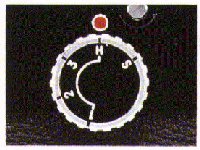 Frame Rate Selector: Lets you select motor speed 1,2, or 3 frames, high (H) speed or single frame (S).
Frame Rate Selector: Lets you select motor speed 1,2, or 3 frames, high (H) speed or single frame (S).
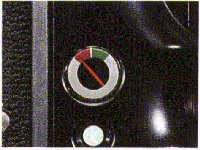 Motor Battery Checker: Push to test.
Motor Battery Checker: Push to test.
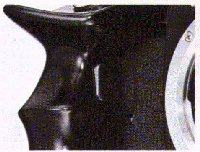 Grip-Sensorswitch: Turns on the auto-exposure circuitry as you grip the camera and off as soon as you remove your hands.
Grip-Sensorswitch: Turns on the auto-exposure circuitry as you grip the camera and off as soon as you remove your hands.
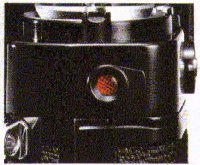 Battery-warning fail-safe device: If the expoure battery is dead, the mirror automatically locks to prevent incorrect exposures. There's also a battery checker for monitoring the battery level at any time.
Battery-warning fail-safe device: If the expoure battery is dead, the mirror automatically locks to prevent incorrect exposures. There's also a battery checker for monitoring the battery level at any time.
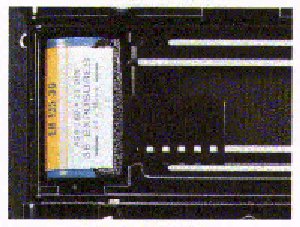 Powered film rewind: A special sensor to stop rewinding before the film is rewound completely into the cartridge for easier darkroom handling.
Powered film rewind: A special sensor to stop rewinding before the film is rewound completely into the cartridge for easier darkroom handling.
Automatic Film-advance stop: A film tension mechanism automatically stops film advance to prevent overwinding when th elast frame of a roll is reached. This operates without the film frame counter being set.
